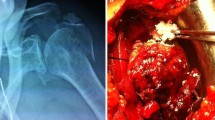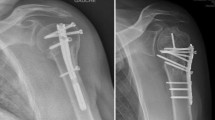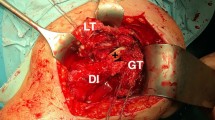Abstract
Background
Proximal humeral fractures in four or even only three parts, with metaphyseal hinge distances of <8 mm, represent a serious and widely debated problem. Reduction is complex and plating is often instable, especially in elderly patients. Failures, sometimes involving necrosis of the head, are frequent. Hemiarthroplasty has long been used for 3- or 4-part complex fractures, even in young patients, although often with sub-optimal results, due to reabsorption of tuberosities. This complication has partly been overcome with reverse shoulder prostheses which, although more invasive than partial ones, may lead to less disappointing results, even in cases of reabsorption of tuberosities. We have data on a homogeneous series of patients treated with reverse shoulder arthroplasty for proximal fractures, with a maximum follow-up of 10 years. The aim of this study was mainly to identify which cases can be selected for effective treatment and which technical aspects are best to adopt.
Materials and methods
There were 33 patients in this study, mean age 76.6 years (range 54–85). Fractures were classified according to Neer. Surgery was undertaken on average 4.4 days after trauma. The deltopectoral approach was used. Sutures were hooked over the major and lesser tubercles for later reduction and fixation after the prosthesis had been applied. This passage was sometimes not possible in cases of serious degeneration of the rotator cuff. One day after surgery, a shoulder brace providing an abducted angle of 15° was applied for 30 days. Patients were re-assessed with DASH and Constant scores (CS), and the ratio between healthy and operated shoulders was calculated. Physical examination was followed by X-rays, mainly to evaluate and classify any infraglenoid scapular notching according to Nerot.
Results
Mean follow-up was 42.3 months (range 10–121). According to the CS, mean pain was 12.6/15 (range 3–15/15), activities of daily living 16.3/20 (range 8–20/20), ROM 21.8 (range 8–32/40) and power 5.4/25 (range 2–12/25). Total mean CS was 56.4 (range 23–80/100). The mean DASH score was 49.7 (range 32–90). The ratio of the CS parameters between opposite and operated shoulders was on average 72.8 % (range 28–90 %). Long-term complications were eight cases of scapular notching (24.2 %) of which four of grade 2 (12.1 %) and four of grade 1 (12.1 %).
Conclusions
Total reverse prostheses are more invasive because they also compromise the glenoid surface of the scapula, but they do offer good stability, even in cases of damage to the rotator cuff. Reverse prostheses have great advantages as regards to ROM, allowing functional recovery, which is good in cases with re-insertion of tuberosities, and acceptable in cases when tuberosities are not re-inserted or resorbed. In our cases, the first 3 reverse prostheses lasted 10, 8.3 and 7.3 years, and we believe that they will become increasingly long-lived, so that applying them in cases of complex fractures becomes more feasible. We prefer the deltopectoral approach because it can reduce and stabilize possible intra-operative diaphyseal fractures. Possible scapular notching must be foreseen when inserting the glenosphere. We had eight cases (24.2 %), of which four were Nerot grade 1 and four were grade 2. Applying the Kirschner wire in an infero-anterior position allows the glenosphere to be lowered with a tilt of 10°. Reverse prostheses are suitable for 3- or 4-part complex proximal humeral fractures in patients over 65. Prolonged physiokinesitherapy is essential.



Similar content being viewed by others
References
Min W, Davidovitch RI, Tejwani NC (2012) Three-and four-part proximal humerus fractures. Evolution to operative care. Bull NYU Hosp Jt Dis 70:25–34
Boons HW, Goosen JH, van Grinsven S, van Susante JL, van Loon CJ (2012) Hemiarthroplasty for humeral four-part fractures for patients 65 years and older: a randomized controlled trial. Clin Orthop Relat Res 470:3483–3491
Babst R, Brunner F (2007) Plating in proximal humeral fractures. Eur J Trauma Emerg Surg 4:345–356
Klitscher D, Blum J, Andreas D, Hessmann M, Kuechle R, Du Prel JB, Rommens PM (2008) Osteosynthesis of proximal humeral fractures with the fixed angle Philos-plate. Eur J Trauma Emerg Surg 1:29–36
Schliemann B, Siemoneit J, Theisen Ch, Kösters C, Weimann A, Raschke MJ (2012) Complex fractures of the proximal humerus in the elderly—outcome and complications after locking plate fixation. Musculoskelet Surg 96(Suppl 1):S3–11
Shahid R, Mushtaq A, Northover J, Maqsood M (2008) Outcome of proximal humerus fractures treated by PHILOS plate internal fixation. Experience of a district general hospital. Acta Orthop Belg 74:602–608
Kontakis G, Koutras C, Tosounidis T, Giannoudis P (2008) Early management of proximal humeral fractures with hemiarthroplasty: a systematic review. J Bone Joint Surg Br 90:1407–1413
Mighell MA, Kolm GP, Collinge CA, Frankel MA (2003) Outcomes of hemiarthroplasty for fractures of the proximal humerus. J Shoulder Elbow Surg 12:569–577
Boileau P, Krishnan SG, Tinsi L, Walch G, Coste JS, Molé D (2002) Tuberosity malposition and migration: reasons for poor outcomes after hemiarthroplasty for displaced fractures of the proximal humerus. J Shoulder Elbow Surg 11:401–412
Hasan SS, Leith JM, Campbell B, Kapil R, Smith KL, Matsen FA 3rd (2002) Characteristics of unsatisfactory shoulder arthroplasty. J Shoulder Elbow Surg 11:431–441
Kralinger F, Schwaiger R, Wambacher M, Farrell E, Menth-Chiari W, Lajtai G, Hübner C, Resch H (2004) Outcome after primary hemiarthroplasty for fracture of the head of the humerus. A retrospective multicentre study of 167 patients. J Bone Joint Surg Br 86:217–219
Bufquin T, Hersan A, Hubert L, Massin P (2007) Reverse shoulder arthroplasty for the treatment of three-and four-part fractures of the proximal humerus in the elderly: a prospective review of 43 cases with a short-term follow-up. J Bone Joint Surg Br 89:516–520
Gallinet D, Adam A, Gasse N, Rochet S, Obert L (2013) Improvement in shoulder rotation in complex shoulder fractures treated by reverse shoulder arthroplasty. J Shoulder Elbow Surg 22:38–44
Neer CS (1970) Displaced proximal humeral fractures. Classification and evaluation. J Bone Joint Surg Am 52:1077–1089
Constant CR, Mourley AHG (1987) A clinical method of functional assessment of the shoulder. Clin Orthop Relat Res 214:160–164
Valenti PH, Boutens D, Nerot C, Oldroyd GED (2001) Delta 3 reversed prosthesis for osteoarthritis with massive rotator cuff tear: long term results (> 5 years). In: Walch G, Boileau P, Molé D (eds) 2000 shoulder prostheses: two to ten years follow-up. Ed. Sauramps Medical, Montpellier, pp 253–259
Gerber C, Schneeberger AG, Vinh TS (1990) The arterial vascularization of the humeral head. An anatomical study. J Bone Joint Surg Am 72:1486–1494
Hertel R, Hempfing A, Stiehler M, Leunig M (2004) Predictors of humeral head ischemia after intracapsular fracture of the proximal humerus. J Shoulder Elbow Surg 13:427–433
Fjalestad T, Hole MØ, Hovden IA, Blücher J, Strømsøe K (2012) Surgical treatment with an angular stable plate for complex displaced proximal humeral fractures in elderly patients: a randomized controlled trial. J Orthop Trauma 26:98–106
Robinson CM, Page RS, Hill RM, Sanders DL, Court-Brown CM, Wakefield AE (2003) Primary hemiarthroplasty for treatment of proximal humeral fractures. J Bone Joint Surg Am 85:1215–1223
Nijs S, Broos P (2009) Outcome of shoulder hemiarthroplasty in acute proximal humeral fractures: a frustrating meta-analysis experience. Acta Orthop Belg 75:445–451
Gallinet D, Clappaz P, Garbuio P, Tropet Y, Obert L (2009) Three or four parts complex proximal humerus fractures: hemiarthroplasty versus reverse prosthesis: a comparative study of 40 cases. Rev Chir Orthop Traumatol 95:48–55
Olerud P, Ahrengart L, Ponzer S, Saving J, Tidermark J (2011) Hemiarthroplasty versus nonoperative treatment of displaced 4-part proximal humeral fractures in elderly patients: a randomized controlled trial. J Shoulder Elbow Surg 20:1025–1033
Aldegheri R, Iacobellis C (2009) La sostituzione protesica nelle fratture prossimali d’omero nell’anziano. G. I. O.T. 35: 6–15
Cazeneuve JF, Cristofari DJ (2009) Delta III C: radiological outcome for acute complex fractures of the proximal humerus in elderly patients. Rev Chir Orthop Traumatol 95:325–329
Guery J, Favard L, Sirveaux F, Oudet D, Mole D, Walch G (2006) Reverse total shoulder arthroplasty. survivorship analysis of eighty replacements followed for five to ten years. J Bone Joint Surg Am 88:1742–1747
Terragnoli F, Zattoni G, Damiani L, Caprioli A, Li Bassi G (2007) Treatment of proximal humeral fractures with reverse prostheses in elderly patients. J Orthopaed Traumatol 8:71–76
Stecco C, Gagliano G, Lancerotto L, Tiengo C, Macchi V, Porzionato A, De Caro R, Aldegheri R (2010) Surgical anatomy of the axillary nerve and its implication in the transdeltoid approaches to the shoulder. J Shoulder Elbow Surg 19:1166–1174
Roche CP, Marczuk Y, Wright TW, Flurin PH, Grey S, Jones R, Routman HD, Gilot G, Zuckerman JD (2013) Scapular notching and osteophyte formation after reverse shoulder replacement: radiological analysis of implant in male and female patients. J Bone Joint Surg Br 95:530–535
Boileau P, Moineau G, Roussanne Y, O’Shea K (2011) Bony increased-offset reversed shoulder arthroplasty: minimizing scapular impingement while maximizing glenoid fixation. Clin Orthop Relat Res 469:2558–2567
Brorson S, Rasmussen JV, Olsen BS, Frich LH, Jensen SL, Hróbjartsson A (2013) Reverse shoulder arthroplasty in acute fractures of the proximal humerus: a systematic review. Int J Shoulder Surg 7:70–78
Muh SJ, Streit JJ, Wanner JP, Lenarz CJ, Shishani Y, Rowland DY, Riley C, Nowinski RJ, Edwards TB, Gobezie R (2013) Early follow-up of reverse total shoulder arthroplasty in patients sixty years of age or younger. J Bone Joint Surg Am 95:1877–1883
Lévigne C, Garret J, Boileau P, Alami G, Favard L, Walch G (2011) Scapular notching in reverse shoulder arthroplasty: is it important to avoid it and how? Clin Orthop Relat Res 469:2512–2520
Nicholson GP, Strauss EJ, Sherman SL (2011) Scapular notching: recognition and strategies to minimize clinical impact. Clin Orthop Relat Res 469:2521–2530
Conflict of interest
None.
Author information
Authors and Affiliations
Corresponding author
Rights and permissions
About this article
Cite this article
Iacobellis, C., Berizzi, A., Biz, C. et al. Treatment of proximal humeral fractures with reverse shoulder arthroplasty in elderly patients. Musculoskelet Surg 99, 39–44 (2015). https://doi.org/10.1007/s12306-014-0331-2
Received:
Accepted:
Published:
Issue Date:
DOI: https://doi.org/10.1007/s12306-014-0331-2




